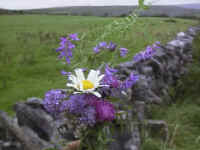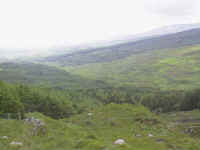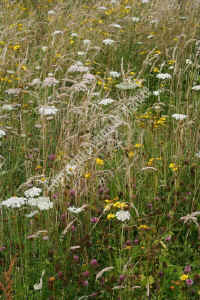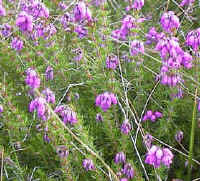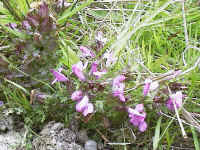|
If purchasing this seed mix, print this page and keep it as your reference.
Native Origin Irish Wildflower Seed Mixture: Range: Meadow Mixtures (Code MM) Supplied without grass, Grass seed can be added Product Name: MM05 Peat-lands or Soil with a high peat content
Product Code: MM05
Description: MM05 offers a choice of cold hardy, colourful species otherwise unavailable anywhere else. Best in full sun, this mixture is for acid, neutral or alkaline peat soil, lowland or upland. Sow MM05 onto limestone marl, gley, clay or subsoil mixed up with the surface peat.
Suitable
sites for this flora can be found across much of Central,
Seed
mixture MM05 will give all our customers in the midlands, This
mixture is will grow in soils derived from
Blanket Bog or Raised Bog, Instead
a bespoke peatlands mixture is required and is mainly supplied
Species List: Bell Heather, Greater and Birdsfoot Trefoil, Bog Asphodel, Bog Cotton, Common figwort, Devil's Bit Scabious, Eyebright, Fleabane*, Foxglove, Broadleaf Plantain,, Lesser Knapweed, Marsh Bedstraw, Marsh Cinquefoil, Marsh ragwort, Meadow Buttercup, Meadow Rue, Meadowsweet, Ox-eye Daisy. Purple Loosestrife, Ragged Robin, Red Bartsia, Red Campion, Red Clover, Red Rattle*, Ribwort Plantain, Rough Hawksbit, Sorrell, Water Avens, Woundwort, Wild Angelica, Wild Carrot, Wild Valarien, Yarrow, Yellow Flag Iris, Yellow Rattle, Redshank,can be added as a nurse crop
MM05
is a general mixture suitable for where the bog is disturbed,
With modern earth moving machines, house builders can infill and
peat and will accommodate and offer a home for species
We supply this flora to compliment 'reed infiltration beds'
Fields created in areas of blanket bog often have a slightly
different ecology
as seaweed or manure may
have been added to the soil over the years.
MM05 contains annuals which would not normally be found in such sites, but will add
first year interest and are intended as a nurse crop in situations that
are often hostile to small perennial seedlings, so we add the annuals so
you get something in the first year. they also act a a marker for the
perennials. Forestry is displacing Irelands peat land wild plant community, so if you grow MM05 you will be helping the conservation of nature and another generation of plants. Seed
Mixture Specifications:
Life Cycle: Annual / Biennial /
Perennial.
Fertility Range: Will
grow on any soil, the less fertile the soil, the
less cutting will be required.
Sowing Specification:
Sowing Conditions:
Normal, roll or rake into surface to
keep out of reach from birds.
Seed Sowing Rates:
Grass seed or nurse crop requirement: Nurse
Crop: No nurse crop is required. If sown without grass seed, this mixture: Will not require a nurse crop.
Morphology:
Life Cycle: Annual / Biennial /
Perennial. Design Notes: MM05 will require an open sward, to allow some species to flourish, if sedges can be encouraged instead of grasses all the better. The presents of heather requires careful cutting in the early years to allow for its establishment. Once established the heather species can be keep low to 12 cm with a general annual cut. Moss will form on the soil surface which may need occasional raking every few years. DBN does not recommend chemically treating the moss to get ride of it.
Performance: Peaty soil are difficult if
saturated. Seek advice if sowing onto flooded peat species will continue to germinate and emerge,
through to the third year. The annuals supplied in this mixture ' may' grow and flower, it depends on what type of peat you have, for the annuals to be successful. This mixture requires one cut when finished
flowering in year one..
Second Year: In the second year the biennials
will also be very colourful.
In the third year this meadow mixture will seem
to have less flora than the first and second year. Why?
When
should this meadow be established and require one cut? A wildflower meadow should last many years, provided the wildflower species were correctly established, weeds were controlled and the meadow was cut and the cut material removed and occasional 'Gaps' are created. If not contact DBN.
Persistence if unmanaged: Low Disposal of cut materials: Always remove the cuttings, wildflower meadow hay should be removed as soon as possible and not be heaped on site as it will grow mouldy (a health risk). Meadow cuttings can be spread as compost in sheet mulches around trees and shrubs or composted. Management: Control grasses and weeds until well established. Accept any normal non-invasive weeds as they provide cover, once the sward is established, digging, spot spraying or weed wiping can be used to eliminate problem species. Control weeds, especially Creeping Buttercup, if Creeping Buttercup is present cut this meadow in May in year two. Most species in this mixture are 'Browse' resistant by wild animals.
Product Warning: DBN recommends that this mixture is not for human or animal consumption.
A
General Description of Meadow Range:
Your purchase:
Contributes to DBN's work of creating crops
of Conservation Grade - Native Origin Wildflora. You help us to inform
and pay land-owners to manage native species and to assist DBN in
handing on our heritage for another generation.
|
